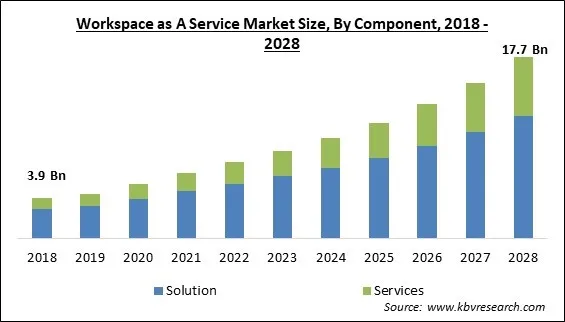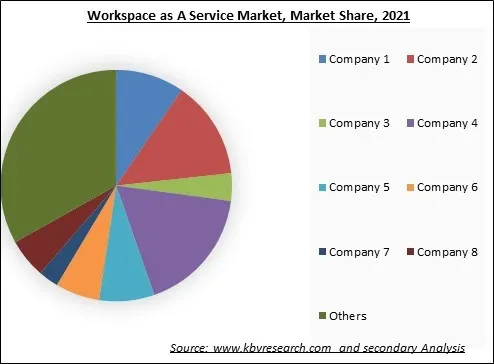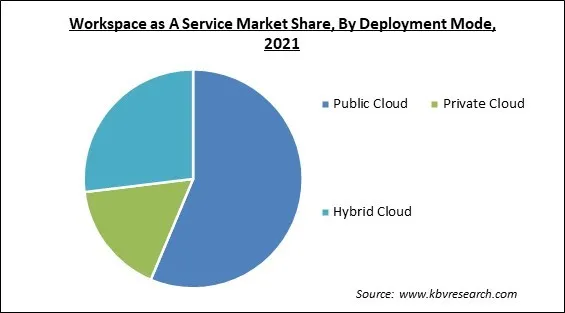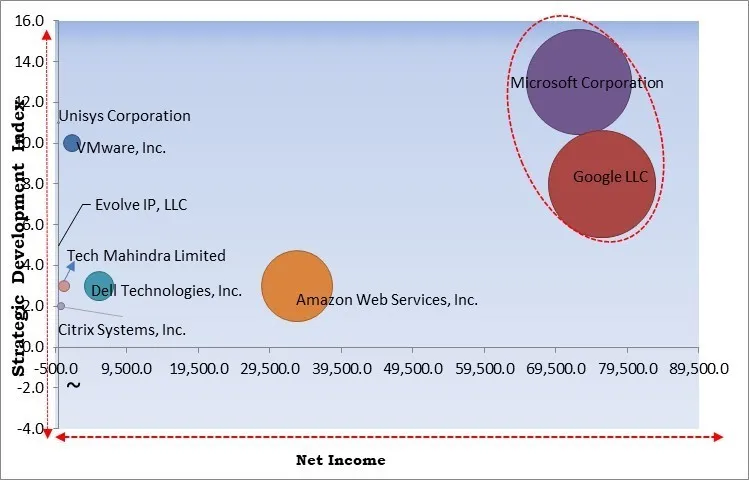The Global Workspace as A Service Market size is expected to reach $17.7 billion by 2028, rising at a market growth of 15.4% CAGR during the forecast period.
Workspace as a service (WaaS) is an expansion of Desktop as a Service (DaaS), which offers a virtualized desktop environment without the other programs and utilities. Users who use WaaS have access to fully operational workspaces managed, maintained, and secured by a service provider. It goes further by giving staff members access to all the information and tools they require, whether seated at a desk or working remotely on a tablet or smartphone.

Also, users of this service only need to use their login credentials to access their work to gain access to everything they require, including business software that they might not be able to operate on their laptops or personal PCs. Additionally, this links any device anywhere and contains all of the features in a traditional office setting, including backup, VPN access, the cloud, security guidelines, and endpoint protection.
Workspace as a service solutions boost agility and productivity by enabling employees to work remotely, interact in real-time, and access their workplaces on any device. Employees may access the resources they require to work productively from any location, including the workplace, their homes, or while on the go, due to the workspace as a service solution.
In addition, employees may readily share information and collaborate in real-time, which helps boost collaboration and communication. Also, it can assist firms in automating procedures and streamlining operations, boosting output and lowering errors. Thus, the workspace as a service market can assist organizations in achieving their goals and propels market growth by giving employees the resources they need to work successfully and communicate.
Businesses can utilize WaaS solutions to have numerous users logged onto the same virtual Windows server. In addition, the additional maintenance requirements and expenses of the virtual desktop environments are also reduced as WaaS providers take care of resource provisioning, load balancing, and network difficulties. WaaS has thus evolved as an accessible solution that meets the enterprise's needs for desktop virtualization.
The spread of COVID-19 has had a beneficial effect on the workspace as a service market. As a result of the pandemic outbreak, businesses worldwide have implemented work-from-home policies, which has resulted in an increased demand for WaaS solutions for the effective workflow of businesses. Because of the breakout of COVID-19, there has been a significant increase in the general use of business continuity tools and workplace solutions and the expanding demand for cloud-based business continuity products. In addition, organizations have devised new ways of delivering training, as well as enhancing team bonding and collaboration, with the assistance of virtual workplaces.
The system allows employees to work outside the workplace. This enables people to work additional hours from their homes to fulfill deadlines. Additionally, BYOD policies enable the workspace as a service industry to save money and become more agile and flexible. Consequently, it is anticipated that the WaaS industry will expand as organizations attempt to optimize IT spending and capitalize on the benefits of BYOD policies. The workspace as a service market is mostly driven by the desire for organizations to reduce their capital expenditures. Hence, the workspace as a service market is anticipated to grow significantly due to the increased acceptance of BYOD policies.

The leading players in the market are competing with diverse innovative offerings to remain competitive in the market. The illustration shows the percentage of revenue shared by some of the leading companies in the market. The leading players of the market are adopting various strategies in order to cater demand coming from the different industries. The key developmental strategies in the market are Product Launches and Product Expansions.
Workspace-as-a-service solutions are more economical than traditional IT infrastructure solutions because they decrease the need for hardware, maintenance, and personnel. In addition, cloud computing technology simplifies time- and cost-intensive business operations, such as license management and software deployment, thereby dramatically reducing the workload of IT administration in businesses. In addition, with the workspace as a service model, new workplaces for additional employees may be set up fast. As a result, this can free up resources for firms to focus on other aspects of their operations, which can be especially advantageous for businesses pursuing development.
A team manager should be given all the instructions and training necessary to operate the solution after receiving a new resource performance tracker. To advance and change with the workplace transformation plan, firms must create training programs as ongoing processes before implementing digital workplace solutions and services. This, in turn, serves as a barrier to the adoption of solutions for the transformation of the digital workplace because they demand continuing organizational training initiatives. These elements may limit the growth of the workspace as a service market.
Based on component, the workspace as a service market is segmented into solution, and services. In 2021, the solution segment held the highest revenue share in the workspace as a service market. This is explained by organizations using virtual desktop infrastructure (VDI), unified endpoint management (UEM), application virtualization, and collaborative solutions to give employees secure and dependable access to their work environment from any location.

By deployment mode, the workspace as a service market is fragmented into public cloud, private cloud and hybrid cloud. In 2021, the hybrid cloud segment recorded a remarkable revenue witnessed the largest revenue share in the workspace as a service market. Due to its ability to store backup or legacy data for an extended period, hybrid clouds are commonly used. Hybrid clouds can also transform traditional IT infrastructure into a service model with improved flexibility, fewer operational activities made possible by automated administrative tasks, self-service access to infrastructure and applications, and best-practice IT resource usage.
On the basis of enterprises size, the workspace as a service market is divided into large enterprises, and small & medium enterprises. The large enterprises segment dominated the workspace as a service market with maximum revenue share in 2021. Numerous large organizations are adopting cloud technology and novel solutions that are easy to consume and powered by artificial intelligence and other automation technologies or software. As a result, large corporations use desktop virtualization technology more than small and medium-sized businesses, contributing to the market's growth.
Based on industry vertical, the workspace as a service market is bifurcated into BFSI, IT & telecom, retail, healthcare, manufacturing, government, travel & hospitality, education and others. The BFSI segment projected a prominent revenue share in the workspace as a service market in 2021. This is because the BFSI industry increasingly utilizes digital workplace services and solutions. In the BFSI industry, widespread deployment of digital workstations reduces office expenses and other associated with functional expenditures, certifies administrative regulations, and enhances operational capabilities.
| Report Attribute | Details |
|---|---|
| Market size value in 2021 | USD 6.4 Billion |
| Market size forecast in 2028 | USD 17.7 Billion |
| Base Year | 2021 |
| Historical Period | 2018 to 2020 |
| Forecast Period | 2022 to 2028 |
| Revenue Growth Rate | CAGR of 15.4% from 2022 to 2028 |
| Number of Pages | 290 |
| Number of Table | 483 |
| Report coverage | Market Trends, Revenue Estimation and Forecast, Segmentation Analysis, Regional and Country Breakdown, Competitive Landscape, Market Share Analysis, Companies Strategic Developments, Company Profiling |
| Segments covered | Component, Deployment Mode, Enterprises Size, Vertical, Region |
| Country scope | US, Canada, Mexico, Germany, UK, France, Russia, Spain, Italy, China, Japan, India, South Korea, Singapore, Malaysia, Brazil, Argentina, UAE, Saudi Arabia, South Africa, Nigeria |
| Growth Drivers |
|
| Restraints |
|
Region wise, the workspace as a service market is analyzed across North America, Europe, Asia Pacific and LAMEA. In 2021, the North America region led the workspace as a service market by generating the highest revenue share. This is because there is a growing demand for workspace as a service solution customized to individual company requirements and an increased emphasis on security measures to guard against cyber threats. In addition, due to the region's considerable manufacturing, retailing, and automotive activities, software and robotics solutions are in great demand. In the end, this influences the growth of the regional market.
Free Valuable Insights: Global Workspace as A Service Market size to reach USD 17.7 Billion by 2028

The major strategies followed by the market participants are Product Launches. Based on the Analysis presented in the Cardinal matrix; Microsoft Corporation and Google LLC are the forerunners in the Workspace as A Service Market. Companies such as Amazon Web Services, Inc. (Amazon.com, Inc.), VMware, Inc., and Dell Technologies, Inc. are some of the key innovators in Workspace as A Service Market.
The market research report covers the analysis of key stake holders of the market. Key companies profiled in the report include Microsoft Corporation, Dell Technologies, Inc., VMware, Inc., Google LLC (Alphabet, Inc.), Unisys Corporation, Amazon Web Services, Inc. (Amazon.com, Inc.), Citrix Systems, Inc. (Cloud Software Group, Inc.), Tech Mahindra Limited, Colt Technology Services Group Limited (Fidelity Investments) and Evolve IP, LLC.
By Component
By Deployment Mode
By Enterprises Size
By Vertical
By Geography


The global Workspace as A Service Market size is expected to reach $17.7 billion by 2028.
Cost Effectiveness benefit of WaaS supporting market growth are driving the market in coming years, however, Lack of knowledge and training among workforce restraints the growth of the market.
Microsoft Corporation, Dell Technologies, Inc., VMware, Inc., Google LLC (Alphabet, Inc.), Unisys Corporation, Amazon Web Services, Inc. (Amazon.com, Inc.), Citrix Systems, Inc. (Cloud Software Group, Inc.), Tech Mahindra Limited, Colt Technology Services Group Limited (Fidelity Investments) and Evolve IP, LLC.
The IT & Telecom segment is acquired maximum revenue share in the Global Workspace as A Service Market by Vertical in 2021 thereby, achieving a market value of $4.7 billion by 2028.
The Public Cloud segment is leading the Global Workspace as A Service Market by Deployment Mode in 2021 thereby, achieving a market value of $9.7 billion by 2028.
The North America market dominated the Global Workspace as A Service Market by Region in 2021, and would continue to be a dominant market till 2028; thereby, achieving a market value of $5.8 billion by 2028.
Our team of dedicated experts can provide you with attractive expansion opportunities for your business.

